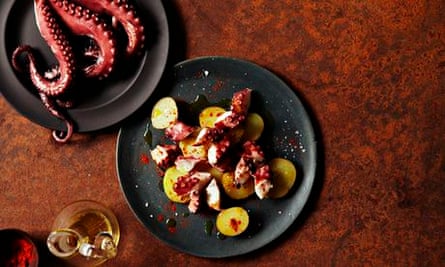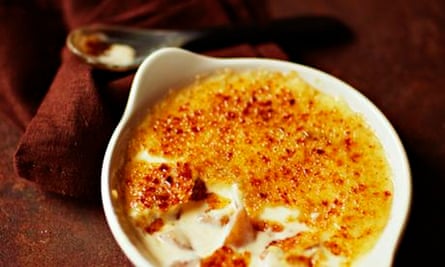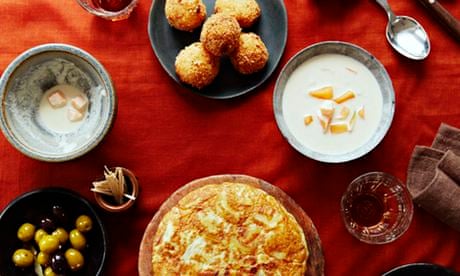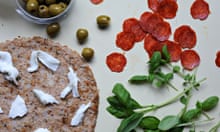Ajo blanco (almond soup) with melon
The ideal spring starter, equally lovely as a refreshing lunch on a hot summer's day.
Seasonal Spanish Food by Jose Pizarro (Kyle Books)
Serves 4
60g crustless, day-old white bread, in rough pieces
750ml water
275g blanched whole almonds
1 garlic clove, chopped
12 tbsp extra virgin olive oil
3 tbsp sherry vinegar, or to taste
Salt
¼ melon, (kharbouza, cantaloupe or honeydew) deseeded and cubed
1 Soak the bread in the water for around 15 minutes until the pieces are soggy, then put the softened bread and the water in a food processor with the almonds, garlic and olive oil and blitz until smooth. Season to taste with sherry vinegar and salt. Transfer to a lidded container and refrigerate until the soup is well chilled; this will take 2-3 hours. Chill the melon cubes at the same time.
2 Give the soup a stir and adjust the seasoning if necessary. Ladle into soup bowls and divide the melon cubes between them. Drizzle with a little olive oil.
Tortilla de patatas
Spain on a plate. We could happily eat this for breakfast, lunch and dinner.
Recipe by Javier Serrano Arribas from The Edible Atlas by Mina Holland (Canongate)
Serves 4
500ml sunflower oil
1kg waxy potatoes, such as desiree, peeled, halved and thickly sliced
1 onion, finely sliced
6 medium eggs
½ tsp salt
Olive oil, for frying
1 Heat the sunflower oil in a deep-sided pan for 5-10 minutes over a medium to high heat. Drop the potatoes and onion into the oil and cook until they start to brown, but not burn. You are essentially boiling the potatoes and onion in the oil, which should be gently bubbling. Keep moving the mixture to prevent it from sticking, then remove from the heat after around 30-40 minutes and drain. You can keep the oil and use to make tortilla another time.
2 In a large bowl, beat together the eggs and the salt, then add the drained potatoes and onion, mashing slightly but retaining a lumpy texture.
3 Heat a glug of olive oil in a large, heavy-based frying pan until smoking, then pour in the potato and egg mixture. After 30 seconds or so, turn down the heat. Cook until the tortilla starts to come away from the sides of the pan slightly and is golden underneath – around 3-5 minutes.
4 To turn the tortilla, take a big plate and slide it on without tipping it – the cooked side of the tortilla should be against the plate. Now turn the tortilla back into the pan so the uncooked side hits the bottom. Cook for a minute or so, then tip back on to the plate and serve.
Galician octopus

This sums up what we love about Spanish cooking – a few good-quality ingredients, assembled simply and perfectly.
Josep Carbonell, Brindisa restaurants, brindisatapaskitchens.com
Serves 4
1 onion, peeled
1 octopus, weighing about 1.5kg-2kg
3 medium potatoes
Olive oil
Paprika
Salt flakes
1 Bring a large pot of water to the boil, then add the peeled onion. Place the octopus in the water then take it out, drain a little and put back in. Repeat this process three times; the octopus should have visibly shrunk. This process is called "asustar el pulpo" which means "scare the octopus".
2 Once done, return to the pan and cook for 40-45 minutes, or until tender. Drain the octopus, reserving the water, then cut the legs into 1cm slices.
3 Boil the potatoes in the same water used to cook the octopus, cool a little then cut into ½cm slices and spread out on a plate. Place the slices of octopus on top, drizzle with a good splash of olive oil, sprinkle with paprika and salt, then serve.
Pisto manchego (Manchegan ratatouille)
Serve this flavoursome feed-a-crowd stew from the La Mancha region with plenty of crusty bread, and a good bottle of Spanish red.
1080 Recipes (Phaidon)
Serves 10
150ml olive oil
200g chorizo, diced
200g cooked ham, diced
1kg onions, chopped
1kg green peppers, seeded and diced
1kg courgettes, diced
1kg ripe tomatoes, peeled and chopped
Salt
1 Heat the oil in a saucepan. Add the chorizo and ham and cook over a low heat, stirring occasionally, for 5 minutes. Remove with a slotted spoon and set aside.
2 Add the onion and green pepper to the pan and cook, stirring occasionally, for 10 minutes. Add the courgette and tomato, mix well, cover and simmer gently for 30 minutes. Season to taste with salt, add the chorizo and ham and heat through for a few minutes. Serve immediately.
Seafood paella
We've tried cooking paella using many different recipes, and eaten a fair few variations, but we always come back to this one by Claudia Roden. This recipe is easily doubled or halved, depending on how many mouths you have to feed.
The Food of Spain by Claudia Roden (Fig Tree)
Serves 4
1 large onion, finely chopped
5 tbsp olive oil
2 garlic cloves, peeled and crushed
2 tomatoes, peeled and chopped
1 tsp each sugar and salt
1 tsp sweet paprika
A good pinch of saffron threads
4 small squid, cleaned, bodies sliced and tentacles left whole
400g Spanish risotto rice
750ml fish or chicken stock, plus more if needed
250ml dry white wine
12 raw king prawns in their shells
16 mussels or clams, cleaned
1 Fry the onion in the oil in a 40cm paella pan over a low heat until soft, stirring often. Stir in the garlic, and before it begins to colour add the tomatoes. Add the sugar, salt, paprika and saffron, stir well; cook over a medium heat until the tomatoes are reduced to a jammy sauce and the oil sizzles. Add the squid; cook, stirring for a minute or so, then add the rice and stir until all the grains are coated.
2 Bring the stock and wine to the boil in a separate pan, pour the mixture over the rice, then add salt to taste. Stir well and make sure the rice is evenly distributed in the pan, then do not stir again. Cook the rice over a low heat for 18-20 minutes, moving the paella around on the hob so that it cooks evenly. Lay the prawns on top of the rice after 10 minutes and turn them over when they turn pink on the bottom side.
3 Add a little more hot stock towards the end of the cooking time if the rice seems too dry and you hear crackly frying noises from the bottom of the pan before it is done, and cover the pan with a large piece of foil. Steam the mussels in a pan with a tight-fitting lid with a finger's depth of water. As soon as they open they are cooked. Throw away any that have not opened and arrange the ones that have on top of the rice, then serve straight away.
Bunyols with hot chocolate
Bunyols are small, deep-fried doughnuts made all over Catalonia and the rest of Spain, especially during Lent. They are traditionally flavoured with a sweet aniseed liqueur, but rose water and really sweet sherry give them a depth of flavour that works much better with thick hot chocolate.
Rachel McCormack, catalancooking.wordpress.com
Serves 8
3 large eggs
50ml rose water
50ml Pedro Ximinez sherry (if you don't have this, use really sweet sherry or wine)
150ml milk
Grated zest of ½ lemon
50g butter
A pinch of salt
1 apple, peeled, cored and grated
500g self-raising flour
1 litre groundnut oil, for frying
Caster sugar, for dusting
For the hot chocolate
30g cornflour
1 litre whole milk
100g sugar
A pinch of ground cinnamon
250g dark chocolate (at least 70% cacao), roughly chopped
1 First make the doughnuts. With a hand blender or using a food processor, whizz together the eggs, sugar, rose water, sherry, milk, lemon zest, butter, salt and grated apple. Once that has all blended add the flour and mix again and leave to settle for about 20 minutes. This dough freezes really well at this stage, so you can save some for another time, if you like.
2 Once the dough has settled heat the oil in a deep pan or deep fat fryer to 160C/320F. You can tell if it is at the right temperature by twisting off and rolling a small ball of dough in your hand and putting it in the oil. If it does not float, the oil is too cold, if it goes brown too quickly, it's too hot – so just adjust the temp as needed. Turn the doughnut over so that the colour is even.
3 Remove the doughnut and place on some kitchen towel to drain quickly, then roll each in a bowl of sugar. Keep them warm while you make the hot chocolate.
4 To make the hot chocolate, dilute the cornflour in a small glass of the milk, then put in a large saucepan with the remaining milk and the sugar over a medium heat, and the cinnamon if you are using it.
5 When the milk begins to boil, add the chocolate pieces and stir them until dissolved, then add the glass of milk diluted with cornflour and stir until thickened. Serve immediately with the bunyols.
Crème catalan with pears and amontillado

A Spanish classic souped up with sherry and pears – try serving this with a glass of amontillado.
Ben Tish, Ember Yard restaurant, saltyardgroup.co.uk
Serves 6
250ml whole milk
250ml double cream
Peeled zest of 1 small orange
Peeled zest of 1 small unwaxed lemon
½ cinnamon stick
½ vanilla pod, seeds removed and set aside
100g caster sugar
1 tsp cornflour
6 large egg yolks
100g demerara sugar
1 large pear (comice or packham) peeled, quartered and core removed
100ml amontillado or oloroso sherry
1 Place the milk, cream, zests, cinnamon, and vanilla pod and seeds in a saucepan and bring slowly to the boil. Remove from the heat and leave for 1 hour to infuse before passing through a sieve.
2 Whisk together the caster sugar, cornflour and egg yolks to incorporate well.
3 Place the infused milk back on the heat in another saucepan. A minute or so before boiling whisk in the egg mix. Reduce to a medium heat and continue to whisk until the custard has thickened – about 5 minutes – and then remove from the heat.
4 Dice the pear into small chunks and then toss with a little of the demerara sugar. Place a small frying pan over a high heat and cook the pears quickly to caramelize before adding the sherry. Reduce the sherry by half and then divide the pears and syrup between 6 ramekins.
5 Spoon the custard mix over the pears then transfer the ramekins to the fridge for a couple of hours to set. Sprinkle a good layer of the demerera sugar on each ramekin and then caramelise with a cook's blowtorch or under a very hot grill. Serve immediately, with a glass of sherry, if you like.
Ham croquetas
Salty ham runs through a rich, creamy bechamel, made even more unctuous when breadcrumbed and deep fried.
Barrafina: A Spanish Cookbook by Sam and Eddie Hart and Nieves Baragan Mohacho (Fig Tree)
Serves 4
250g good quality Serrano ham (one large piece)
Olive oil
120g unsalted butter
115g plain flour
1 litre whole milk
½ tsp freshly grated nutmeg
3 eggs, beaten
250g breadcrumbs
1 litre sunflower or vegetable oil, for deep frying
1 Cut the ham into ½cm cubes, then heat a little olive oil with the butter in a large, heavy-based frying pan and gently cook the ham for about 10 minutes, until most of the fat has rendered off. Stir in the flour and continue to cook over a low heat for 10 minutes, stirring frequently.
2 Bring the milk to a simmer in a small saucepan, then gradually beat the milk into the ham and flour mixture, stirring constantly. Cook for a further 10-15 minutes, until thickened and smooth. Add the nutmeg and then season to taste. Remove from the heat, pour into a bowl or container then cover the surface with clingfilm to stop a skin forming. Chill in the fridge for 4 hours.
3 To make the croquetas, put the beaten egg in one bowl and the breadcrumbs in another, then roll the ham mixture into small, ping pong-sized balls. Dip each in the egg, then the breadcrumbs, then set aside on a tray.
4 Heat the oil in a saucepan to 180C/360F – if you don't have a thermometer, the oil is hot enough when a breadcrumb browns in around 30 seconds. Fry the croquetas in batches for around 3-4 minutes, until golden all over. Serve immediately, while still hot.
Paprika-rubbed pork chops with warm bean dressing
These Spanish-inspired pork chops are our new favourite midweek meal, but they're fancy enough for dinner with friends, too.
Jason Atherton, jasonatherton.co.uk
Serves 8
3 tbsp smoked paprika
100ml olive oil
Salt and black pepper
6 large or 8 small free-range pork chops
For the white bean dressing
2 red onions, roughly chopped
3 large red peppers, deseeded and chopped
2 large green peppers, deseeded and chopped
300ml olive oil (preferably Spanish)
200g smoked bacon lardons, chopped
1 bunch of swiss chard, shredded
3 sprigs of rosemary
1 bunch of oregano
100ml sherry vinegar
1kg cooked butter beans from a tin or jar
1 Rub the paprika, oil and seasoning into the pork and leave in the fridge for 5 minutes.
2 To make the dressing, sweat the onion and peppers in a little of the oil for 5 minutes with the bacon, then stick the pork on the grill or in a frying pan and cook for around 5-6 minutes on each side so the chops are cooked but still tender. Then set the chops aside to rest.
3 Add the swiss chard to the cooked veg, cook for a minute, then add the rosemary, oregano, the rest of the oil and the vinegar and cook for 3 minutes. Add the beans and cook for 5 minutes more, then season with salt and pepper.
4 Place the bean and veg mix on a big serving platter and then arrange the pork on top. Serve in the middle of the table with some nice warm olive bread and olive oil.
Migas
An indulgent but undeniably delicious weekend brunch; morcilla is more authentic, but if you can't find it then good-quality black pudding will be just as good.
Tapas Revolution by Omar Allibhoy (Ebury)
Serves 4
400g stale sourdough bread
Olive oil
1 head of garlic, cloves separated, skins on
50g panceta curada or lardons
50g morcilla or black pudding, thinly sliced
50g fresh chorizo, roughly chopped
1 tsp sweet pimenton
Black pepper
4 eggs
Salt
A handful of grapes, halved
1 Trim away most of the outer crust of the bread and cut the softer inside into 1cm cubes. Sprinkle with cold water, cover with a damp cloth and leave for 30 minutes.
2 Add 2 tbsp olive oil to a large pan over a high heat and start frying the garlic cloves. Add the panceta or lardons, then cook for 2 minutes, stirring. Add the morcilla and chorizo and cook for another 2 minutes.
3 Squeeze out any moisture from the bread cubes, add to the pan and cook for 5 minutes, stirring constantly. Now add the sweet pimenton and a grinding of black pepper and set aside while you cook the eggs.
4 In a small saucepan, heat 200ml olive oil, or to the depth of two fingers, until around 220C/430F, or almost smoking. Crack one of the eggs into a glass, then gently tip into the oil and fry for around 10 seconds, spooning oil over the top of the egg as you do so. Repeat with the remaining eggs, sprinkle with a little salt, then serve on top of the migas with the grapes.








Comments (…)
Sign in or create your Guardian account to join the discussion